f73v Zodiac and Sagittarius page – Marco Ponzi & Darren Worley
A few days I asked if anyone might be prepared to summarise what has been said so far about the Voynich manuscript’s f73v Sagittarius Zodiac page. Marco Ponzi and Darren Worley have very kindly sent me the page below – a huge amount of work and scholarship for which I (and I hope everyone) must feel immensely grateful. Thanks Marco and Darren!
As usual, please feel free to add your comments and views.
Marco and Darren start with some background on the Voynich Zodiac images in general…..
—————–
Ewa Sniezynska-Stolot observations
(For an introduction to Voynich Zodiac f70v-f73v, see D’Imperio, p.16)
In 2001, Rafal T. Prinke translated a brief note by Prof. Ewa Sniezynska-Stolot about the Voynich Zodiac pages. Sniezynska-Stolot, professor at the Jagiellonian University in Cracow, is an expert in the history of art in general and in astrological iconography in particular. She has published many books on the subject, including monographs about the Jewish astrologer Abraham ibn Ezra, the Persian astrologer Abu Ma’shar, the famous manuscript, now in Cracow, of the magic book Picatrix. As far as I know, her only book to have been translated into English is “Astrological iconography in the Middle Ages: the decanal planets†Canjani download. A wider selection of her works is listed on worldcat.
A few passages from Sniezynska-Stolot’s note translated by Prinke:
I have inspected the VMS at Beinecke. The signs of the Zodiac do not present problems – they are simply not of the Arateia type but were modernized. As I wrote in my books, because of linguistic mistakes and changes in artistic styles, human figures were represented in contemporary garments (viz. Gemini, Virgo, Sagittarius). Attributes were changed in the same way, eg. Sagittarius’ bow developed into a crossbow in the 15th c.
The genre scenes, eg. Aries eating a bush, suggest that the signs were redrawn from a calendar. Garments: the jopulas [?] of men with a belt suggest the 14th/15th c. but headdresses of men (Gemini, Sagittarius) definitively indicate the 15th c. This was common fashion in Europe at that time. The Sagittarius’ cap with fox tail points to Germany – but they were also worn in Poland. I believe that the manuscript can be dated to mid-15th c.
In 2013 Ellie Velinska published a number of excellent parallels for some of the dresses and hats. Apparently, the Polish “jopula†mentioned by Sniezynska-Stolot is the kind of doublet “belted at the waist, giving in effect a short skirt below†common in the XV Century (see this article). The tapestry that Ellie discussed illustrates costumes from Burgundy.
Sniezynska-Stolot’observations are also consistent with the point of view of Erwin Panofsky: he thought that the Voynich manuscript was written in Western Europe (most probably in Spain) or Germany, even if he recognized a Jewish or Arab influence 바코드 스캐너 다운로드.
Notes about individual Zodiac signs
Johannes Klein has recently suggested on this site a systematic comparison of different Zodiac cycles with the Voynich Zodiac. That project seems very promising, but it clearly requires a significant effort. Here are some non-systematic, casual considerations: in general, as noted by Sniezynska-Stolot, the images of Voynich zodiac signs depart from Aratus-style constellation images. This seems to me to conform to a general trend in medieval Zodiac illustrations: Zodiac signs are made more similar to images of the “labors of the monthsâ€, a subject that often accompanied the Zodiac in medieval iconography. Illustrations of the signs are made more realistic: Virgo is not represented as an “angelâ€, but as an ordinary wingless girl; the centaur that typically illustrates the Sagittarius constellation is replaced by a human being; Capricorn appears as a normal goat (or kid), not as a fantastic half goat, half fish animal. About specific zodiac signs:
* Sniezynska-Stolot suggested that Aries eating a bush typically appears in calendars. An example (also associated with calendar-like “labours of the monthsâ€) is provided by a XIII Century relief from the Strasbourg cathedral.
* Gemini are usually represented as a dressed couple of males (Castor and Pollux) or as a naked couple of different sexes. Yet some manuscripts and reliefs represent them as a dressed couple of lovers. In this case, the relation with the “labors of the months†is particularly clear, since lovers sometimes appear as illustrations of Spring months (more examples below) arcgis 10.5 크랙.
* Cancer was often illustrated as a Lobster in Europe, while in all the Perso-Arabic examples at the Warburg site it is represented as a Crab.
* Aratus describes Virgo as a winged maiden (which he identifies with Dike, the goddess of justice). This iconography is followed in many ancient sources, but most XV Century images of Virgo produced in central Europe present her without wings.
* In Perso-Arabic sources, Scorpio is clearly recognizable as a scorpion (a common animal in the Near East). On the other hand, some European sources represent fantastic or unrelated animals. This apparent contradiction with respect to the general trend of increased realism is explained by specific reasons: “As many of the artists and illuminators responsible for these works never saw a scorpion or had a model book to work from, the representations of this sign reflect great variety†(Colum Hourihane, “Time in the Medieval World: Occupations of the Months and Signs of the Zodiac in the Index of Christian Artâ€).
Sagittarius with crossbow
As Rene Zandbergen has written here (August 10, 2015), finding actual examples of the Crossbow Sagittarius type discussed by Sniezynska-Stolot in 2001 has taken Voynich researchers almost ten years: those presented on Rene’s site were possibly found only in 2009 and 2015.
Up to now, in addition to Voynich f73v, eight other XV Century examples of a Sagittarius with crossbow have been identified (including those on Rene’s site) windows 10 익스플로러 11 다운로드.
In all these cases, the sign is represented by a human being. The Centaur form is the most frequent in ancient and medieval images, but the “Poeticon astronomicon†apparently suggests that the human and the centaur forms already coexisted in the I or II Century AD: “Many have called this sign the Centaurus; others deny the name, for the reason that no Centaurus makes use of arrows†(II,27). These Crossbow Sagittarius images seem to make part of a single tradition: they were all produced in a time span of about 80 years and in places at most 800 Km apart. Yet it is interesting to note how much they differ from one another. The poses are all notably different, with a few exceptions: one of the latest images (the 1475 Bavarian Ludwig-Maximilians University Library 2° Cod. ms. 578) bears a certain resemblance to the earliest (the 1400ca Polish cod. 1842). More clearly, the 1477ca Heidelberg manuscript illustration seems to have been copied from the 1469ca zodiac wheel in Fugger-Bibliothek Cod.5327 Han.
The German word “hausbuch†(literally, house-book) occurs in the description of many of the manuscripts described below. A Companion to Astrology in the Renaissance gives the following definition: “a kind of almanac, which included, … calendar and astrological information, as well as medical suggestions, usually structured throughout the course of the yearâ€. The examples discussed below exemplify the heterogeneity of hausbuch contents. While it is tempting to draw a parallel between the hausbuch format and the Voynich manuscript, it is also clear that there are differences: the main body of the Voynich manuscript apparently is a herbal, so the contents seem to be both more homogeneous and more strictly “technical†than those of a typical hausbuch. Also, a complex diagram as the so called Rosettes page seems to fit more with an ambitious scientific work than with a house almanac.
In the following paragraphs, a brief discussion of each source is proposed 안재욱 친구 mp3 다운로드. Sources are presented in chronological order, from the earlier to the later.
A. Poland, 1395-1405 – Österreichische Nationalbibliothek – cod. 1842
Up to now, not much information about this manuscript could be found. Apparently, it is a Book of Hours written in Poland (the Latin title is “Horae canonicae in Polonia Scriptaeâ€). The Zodiac cycle also includes a couple of male and female, dressed, embracing Gemini (see Voynich f72r).
B. St.Gall, 1425-28 – St. Gallen Stiftsbibliothek – Cod. Sang. 827
From the on-line description of the manuscript: This composite volume, written between 1425 and 1425[28?] in the Lake Constance regions, though not at the Abbey of St. Gall, contains Latin versions of a great many computistic/astronomical/cosmographical treatises, including the widely disseminated work De sphaera mundi by John of Sacrobosco and his arithmetical foundation work Tractatus de algorismo. The manuscript, organized according to the calendar, also contains illustrations: the twelve signs of the zodiac, a map of the winds, sketches of the ecliptics of the sun and moon, planets and constellations, a diagrammatic guide for bloodletting, a set of early medieval Terra Orbis-type world maps, and (on pages 265 and 266) twelve simple illustrations for the months with brief rhyming proverbs in German derived from the nature- and landscape-dominated everyday life of the people of the late middle ages.
The Sagittarius appears in an addition to the initial Latin Calendar which discusses the best times for bloodletting. The relevant paragraph has been transcribed and translated here Tekken Tag Tournament2 Download.
In the labors of the months illustrations, a couple of lovers represent the month of April.
This was the second crossbow Sagittarius to be found. It was originally published by Rene Zandbergen.
C. Nürnberg, 1429 – Concordia Seminary Library – Medizinisch-astrologisches Hausbuch
From the on-line description of the manuscript: Profusely illustrated in water colors with signs of the Zodiac and miniature paintings showing activities of the seasons and other scenes of daily life. A layman’s “medical manual” – one of seven of the genre known to remain.
The manuscript also includes illustrations of the “labors of the monthsâ€: a couple of lovers represents the month of May. f12v illustrates Sagittarius as a two-legged Centaur armed with a bow. f18c represents Sagittarius as a sitting man with a bow.
f22r features the Crossbow Sagittarius as an illustration of one of the two Zodiac signs ruled by planet Jupiter (here the god resembles illustrations of Mars or of the Perseus constellation). The other sign ruled by Jupiter (Pisces) appears in a circular frame opposite to Sagittarius. Of course the manuscript includes in the preceding and following pages illustrations of the other six planets and ten zodiac signs metal slug romfile. The fact that images are dominated by the personifications of the planets makes this cycle visually very different from the Voynich Zodiac.
D. Konstanz, 1463 – Planeten-Buch – BSB Cgm 7269
In this case, Sagittarius appears on a calendar page corresponding to the month of November. So (similarly to the Voynich manuscript) each Zodiac sign appears on a separate page. Similarly to the 1429 Concordia Seminary Library Hausbuch, f15r illustrates Sagittarius and Pisces at the sides of a large image of Jupiter. In this case, Sagittarius is fully human but he is armed with a bow. The illustrations are particularly carefully painted and they are all surrounded by gilded circular frames.
The manuscript is entirely written in German. It was likely written in 1463, the year that prominently appears on the cover.
This was the first crossbow Sagittarius to be mentioned in relation with the Voynich manuscript. It was originally published by Rene Zandbergen, possibly in 2009.
E. Swabia, 1469? – Fugger-Bibliothek – Cod. 5327 Han
This manuscript seems to be strictly about divination, mainly geomancy. It is written in different hands, partly in Latin and partly in German. The Crossbow Sagittarius appears at p.387, in the context of a detailed Zodiac wheel in which the 360 degrees of the zodiac are clearly and individually marked Download the css font. Darren Worley, who first found and commented this source, noticed that the image was cut and pasted in the manuscript. He also noticed that it appears not to be a drawing but a copper engraving. Since the German text of the manuscript flows just below the image, the diagram was likely pasted before the text was written. It is noteworthy that so far this is the only known image of a Crossbow Sagittarius that makes part of a Zodiac wheel. The date 1469 is inscribed at the end of the manuscript (p.392, f188v).
F. Southern Germany, 1474-1475 – Ludwig-Maximilians University Library – 2° Cod. ms. 578
A medical book written in the Southern German dialect. It contains different images of the zodiac signs. A few of the illustrations have been cut away. The first pages contain illustrations of the planets with the respective ruled signs, but Jupiter seems to be missing. At p.34 a Zodiacal man (melothesia) is represented. Another series of images of the planets follows. This time Jupiter is present (f27r / p.53): his image is Perseus-like, as in the 1429 manuscript described above; Sagittarius here is a man armed with a bow. The Crossbow Sagittarius appears in the last illustration, together with other 9 zodiac signs individually framed in circles (Pisces and Aquarius are missing). This source was also found by Darren Worley.
G 백색소음 mp3 다운로드. Württemberg, 1475 – Universitätsbibliothek Tübingen – Hausbuch – Md 2
This manuscript bears some resemblance with the 1429 manuscript at the Concordia Seminary Library discussed above. It is a complex work, often mentioned in art history texts mainly because it discusses and illustrates the children of the planets (Jupiter with Pisces and Sagittarius – f268r). It also includes many other crossbow-less images of Sagittarius (f6r, f12v,melothesia, f40v, f43r,zodiac wheel, f116r, f323r, star map). Similarly to the 1429 manuscript, f321r, in which the sign is represented as a Crossbowman, makes part (together with Pisces) of an illustration of the ruling planet Jupiter. In this cycle, each Zodiac sign appears as a tower representing a nightly or daily domicile for a specific planet. Saturn, Mars and the Sun (with their respective Zodiac signs) are illustrated on f321r. The cycle illustrating the seven planets and the twelve zodiac signs is concluded on the verso of the same folio. As customary, the Sun has a single domicile (Leo). Strangely, Libra has been duplicated and appears not only in association with Venus, but also as a second domicile for the Moon (together with the typical Cancer). The iconography of Mars in f321r has been modernized as well: one of his two images holds an arquebus. Among the examples listed here, this is the only case in which the Crossbow Sagittarius is not included in any kind of frame: with the exception of the possibly engraved zodiac wheel, all other Crossbow Sagittarii discussed are framed in circles 샤이닝 스타 극장판 다운로드.
Ellie Velinska referred to this manuscript in her 2013 post mentioned above.
H. Bavaria, 1477 – Universitätsbibliothek Heidelberg – Cod. Pal. germ. 291
Another German hausbuch, apparently written in a single hand. It includes astrological, medical, pharmaceutical and devotional texts. The calendar tables at the beginning refer to the time period 1477-1514, so the manuscript was likely written in 1476 or 1477? The Crossbow Sagittarius appears in f17r, in a chapter written in German (or a German dialect) illustrating the properties of the Zodiac signs. The usual illustrations of the planets with their domiciles appear in the following pages (f23v-f29r). The Zodiac cycle was apparently copied from the Zodiac wheel pasted in the 1469 Fugger-Bibliothek manuscript discussed above (or they were both copied from a common source). This could confirm that the wheel is an engraving (so that image had a wider distribution and could more easily be copied). Darren Worley (who first found this source) posted the following comments: “There are two zodiac series shown in this manuscript, … [the first] shows a Sagittarius crossbowman, the second zodiac sequence [representing planetary domiciles] depicts Sagittarius as an archer. The first zodiac series is interesting in that it shows the distinctive cloud-band pattern (on Aries, Taurus and Cancer), which also appears in a celestial context in VM f68v3.â€
- Posted in: Voynich ♦ Voynich Zodiac
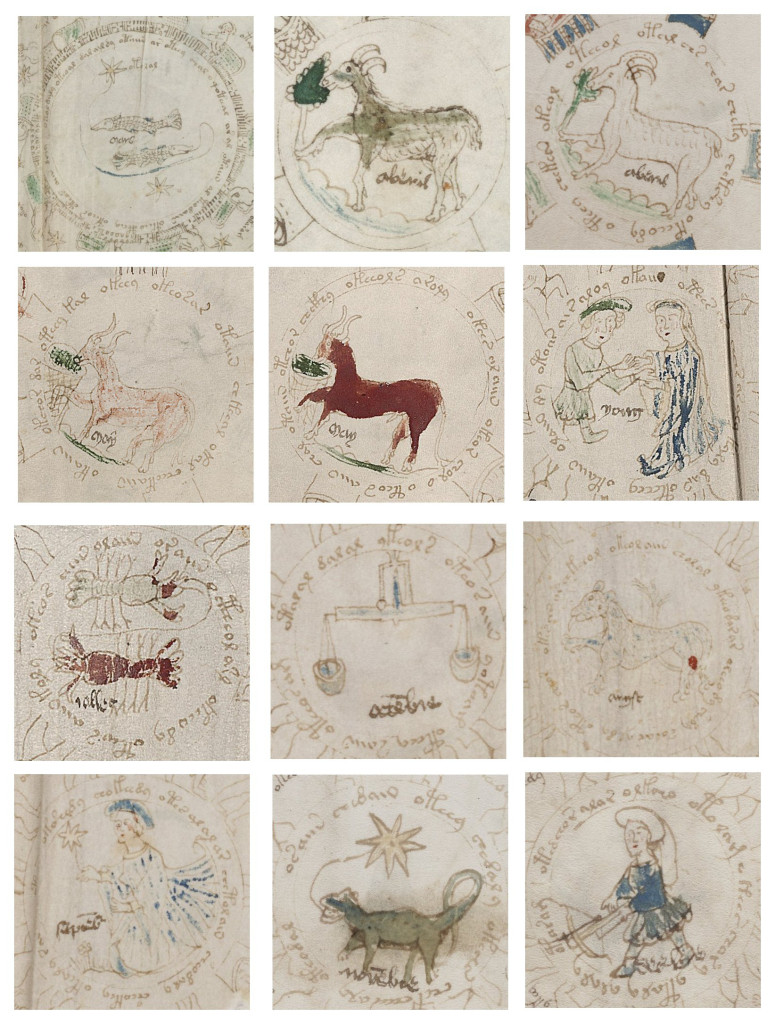
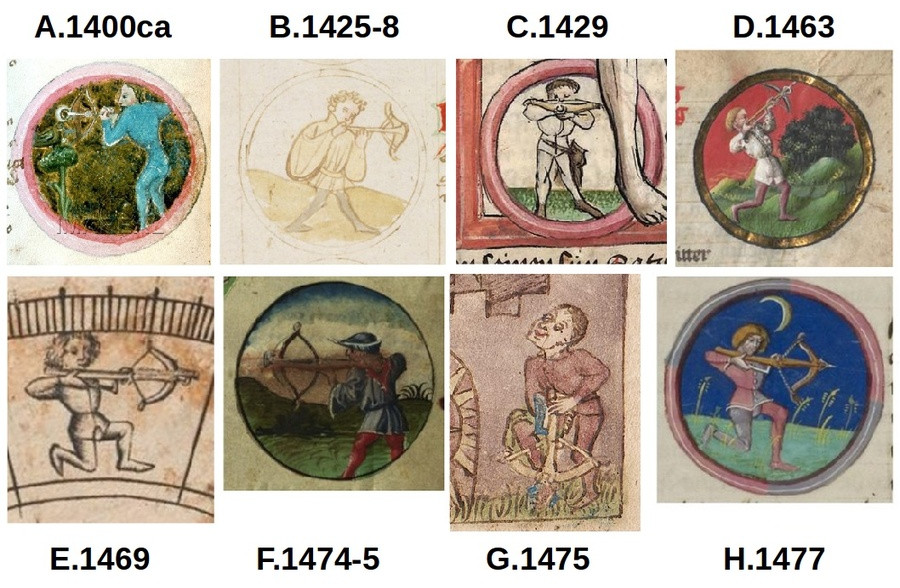
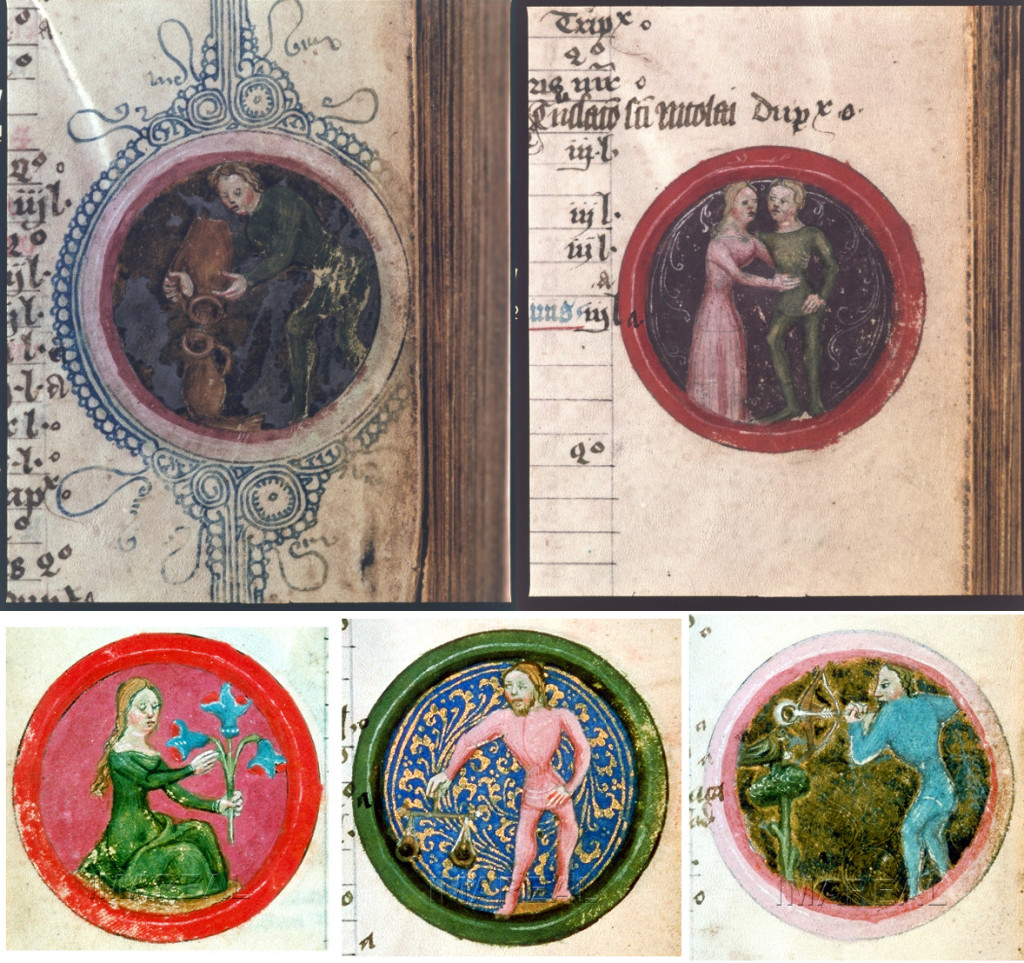
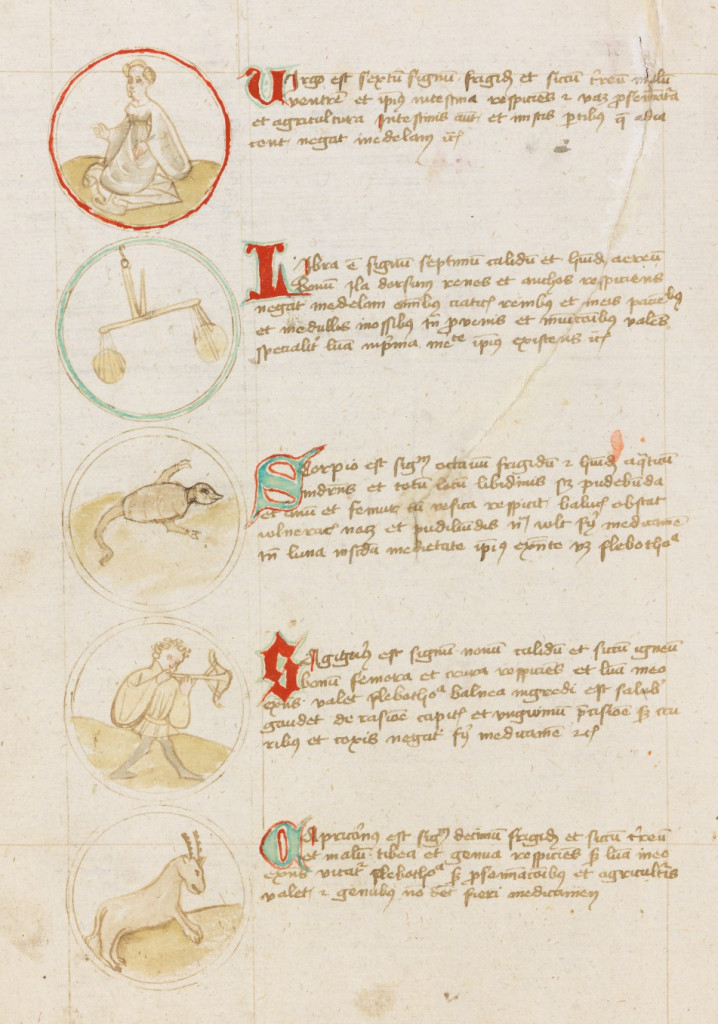
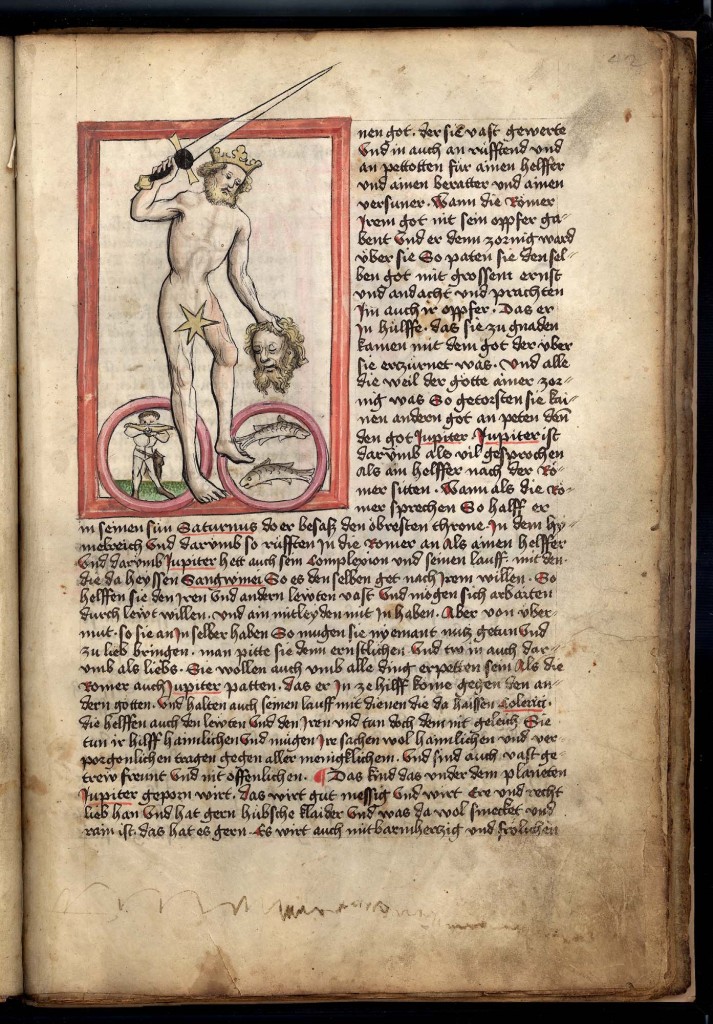
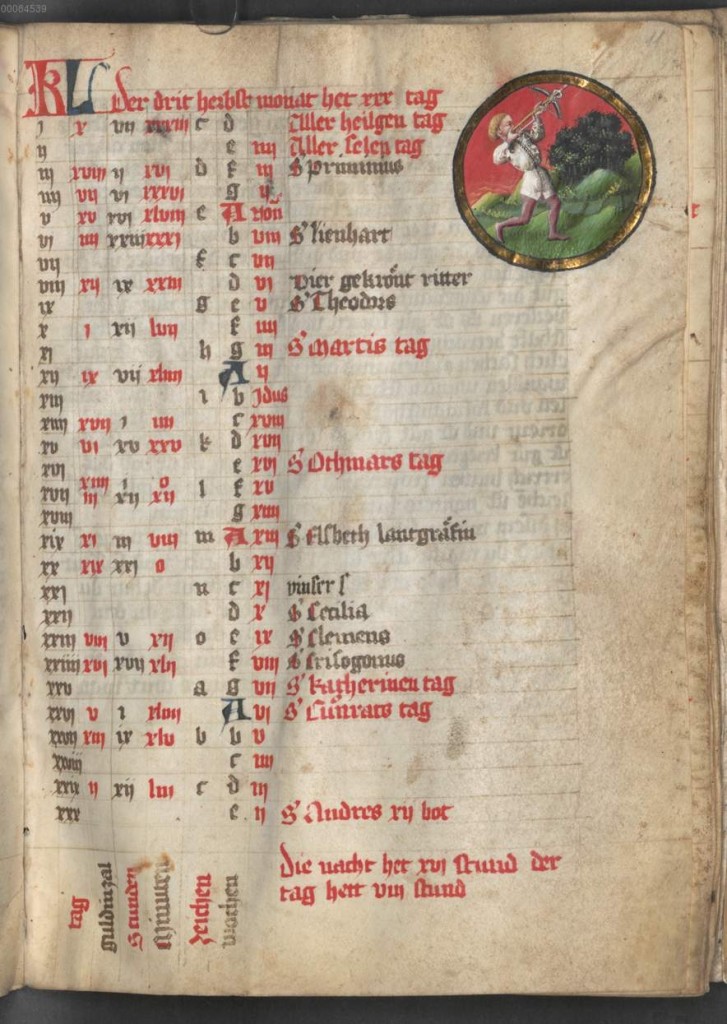
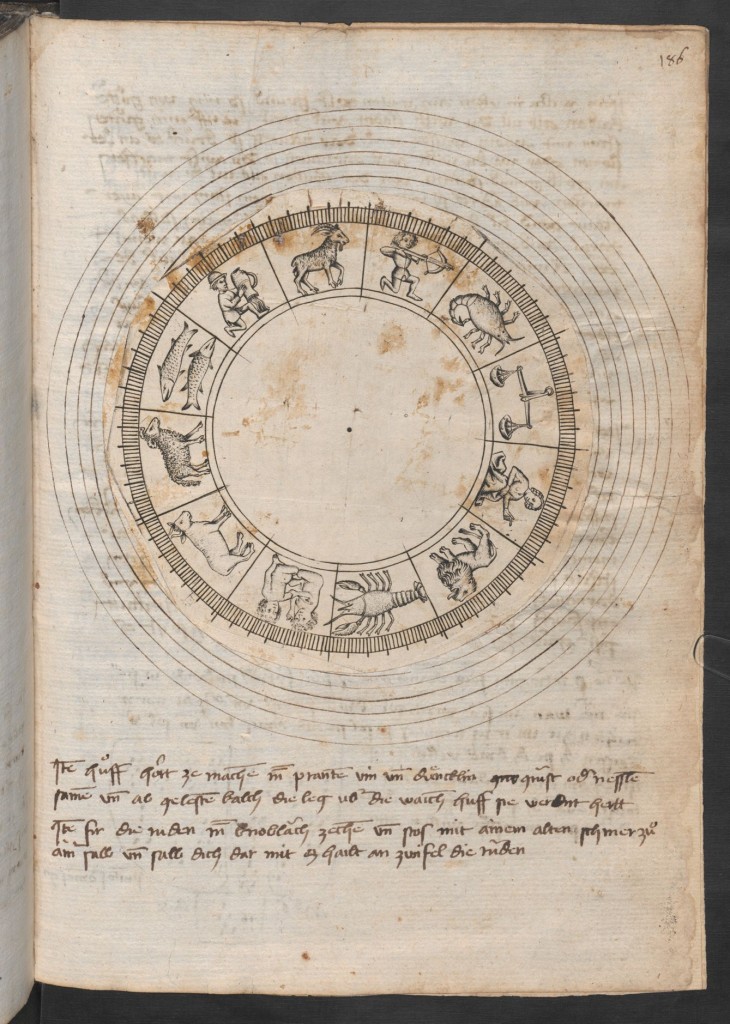
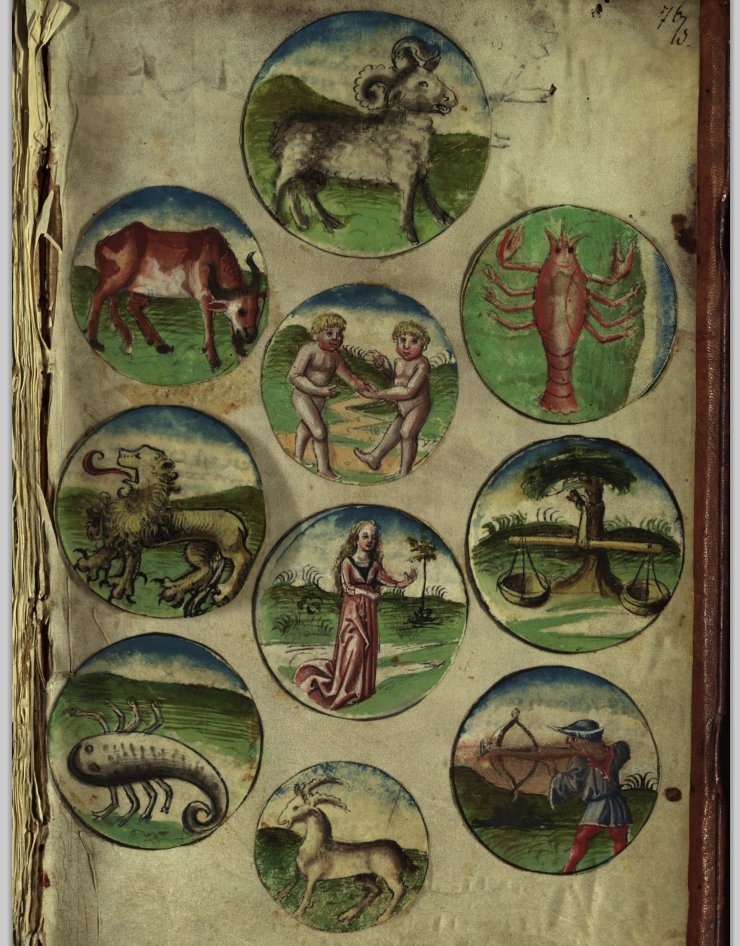
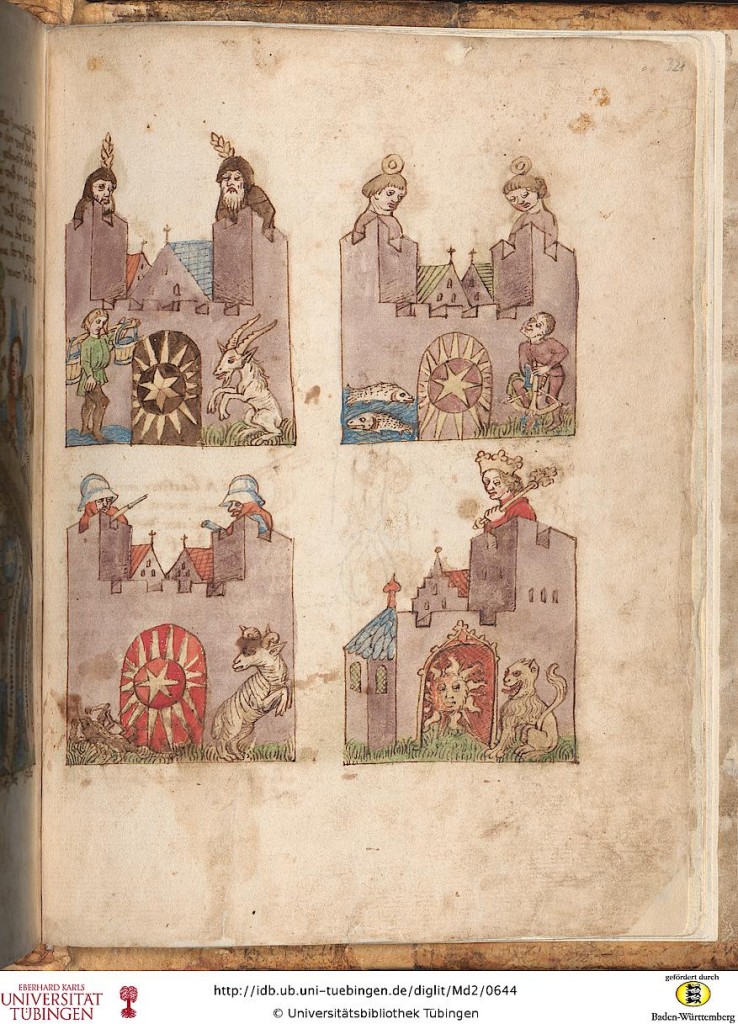
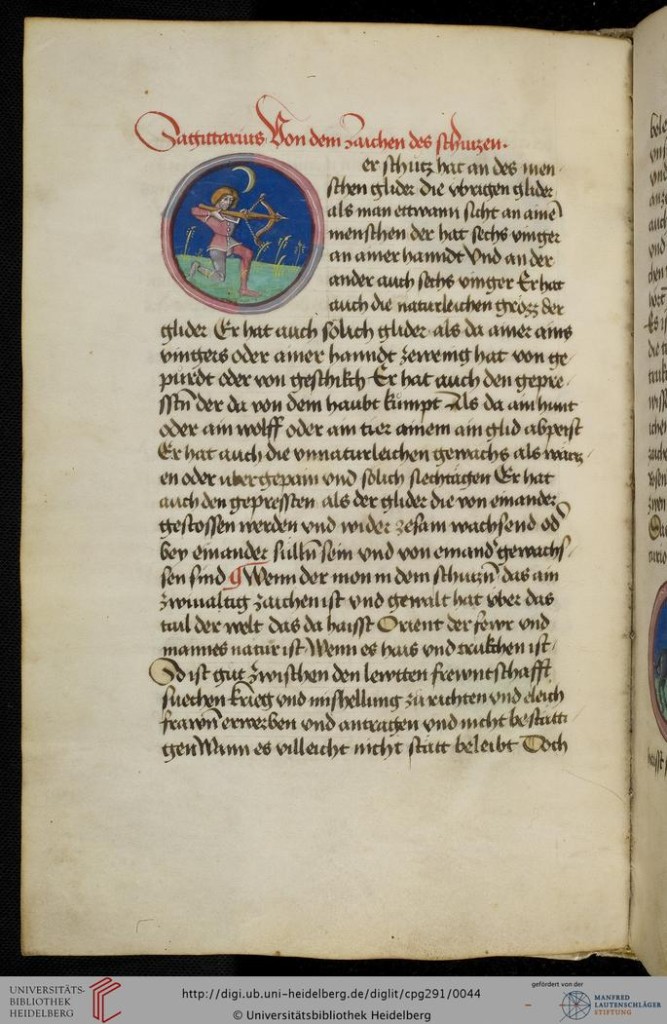
163 Comments
Trackbacks